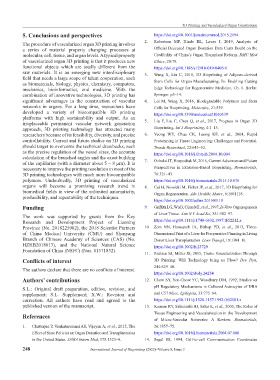Page 256 - IJB-8-3
P. 256
3D Printing and Vascularized Organ Construction
5. Conclusions and perspectives https://doi.org/10.1001/jamainternmed.2015.2194
The procedure of vascularized organ 3D printing involves 2. Robertson MP, Hinde RL, Lavee J, 2019, Analysis of
a series of material property changing processes at Official Deceased Organ Donation Data Casts Doubt on the
molecular, cell, tissue, and organ levels. A typical property Credibility of China’s Organ Transplant Reform. BMC Med
of vascularized organ 3D printing is that it produces new Ethics, 20:79.
functional objects which are totally different from the https://doi.org/10.1186/s12910-019-0406-6
raw materials. It is an emerging new interdisciplinary 3. Wang X, Liu C, 2018, 3D Bioprinting of Adipose-derived
field that needs a large scope of talent cooperation, such
as biomaterials, biology, physics, chemistry, computers, Stem Cells for Organ Manufacturing. In: Enabling Cutting
mechanics, bioinformatics, and medicine. With the Edge Technology for Regenerative Medicine. Ch. 1. Berlin:
combination of innovative technologies, 3D printing has Spirnger. p3–14.
significant advantages in the construction of vascular 4. Lei M, Wang X, 2016, Biodegradable Polymers and Stem
networks in organs. For a long time, researchers have Cells for Bioprinting. Molecules, 21:539.
developed a variety of biocompatible 3D printing https://doi.org/10.3390/molecules21050539
platforms with high sustainability and output. As an 5. Liu F, Liu C, Chen Q, et al., 2017, Progress in Organ 3D
irreplaceable permanent vascular network generation
approach, 3D printing technology has attracted many Bioprinting. Int J Bioprinting, 4:1–15.
researchers because of its feasibility, diversity, and precise 6. Yeong WY, Chua CK, Leong KF, et al., 2004, Rapid
controllability. Current and future studies on 3D printing Prototyping in Tissue Engineering: Challenges and Potential.
should target to overcome the technical drawbacks, such Trends Biotechnol, 22:643–52.
as the precise regulation of the vessel sizes, the accurate https://doi.org/10.1016/j.tibtech.2004.10.004
calculation of the branched angles and the exact building
of the capillaries (with a diameter about 5 – 8 μm). It is 7. Ozbolat IT, Hospodiuk M, 2016, Current Advances and Future
necessary to improve the printing resolution in most of the Perspectives in Extrusion-Based Bioprinting. Biomaterials,
3D printing technologies with much more biocompatible 76:321–43.
polymers. Undoubtedly, 3D printing of vascularized https://doi.org/10.1016/j.biomaterials.2015.10.076
organs will become a promising research trend in 8. Cui H, Nowicki M, Fisher JP, et al., 2017, 3D Bioprinting for
biomedical fields in view of the unlimited automaticity, Organ Regeneration. Adv Healthc Mater, 6:1601118.
producibility, and repeatability of the techniques.
https://doi.org/10.1002/adhm.201601118
Funding 9. Griffith LG, Wu B, Cima MJ, et al., 1997, In Vitro Organogenesis
of Liver Tissue. Ann N Y Acad Sci, 831:382–97.
The work was supported by grants from the Key
Research and Development Project of Liaoning https://doi.org/10.1111/j.1749-6632.1997.tb52212.x
Province (No. 2018225082), the 2018 Scientist Partners 10. Zein NN, Hanouneh IA, Bishop PD, et al., 2013, Three-
of China Medical University (CMU) and Shenyang Dimensional Print of a Liver for Preoperative Planning in Living
Branch of Chinese Academy of Sciences (CAS) (No. Donor Liver Transplantation. Liver Transpl, 19:1304–10.
HZHB2018013), and the National Natural Science https://doi.org/10.1002/lt.23729
Foundation of China (NSFC) (Nos. 81571832).
11. Paulsen SJ, Miller JS, 2015, Tissue Vascularization Through
Conflicts of interest 3D Printing: Will Technology bring us Flow? Dev Dyn,
244:629–40.
The authors declare that there are no conflicts of interest.
https://doi.org/10.1002/dvdy.24254
Authors’ contributions 12. Chow SY, Yen-Chow YC, Woodbury DM, 1992, Studies on
S.L.: Original draft preparation, edition, revision, and pH Regulatory Mechanisms in Cultured Astrocytes of DBA
supplement; S.L. Supplement; X.W.: Revision and and C57 Mice. Epilepsia, 33:775–84.
correction. All authors have read and agreed to the https://doi.org/10.1111/j.1528-1157.1992.tb02181.x
published version of the manuscript. 13. Kannan RY, Salacinski HJ, Sales K, et al., 2005, The Roles of
Tissue Engineering and Vascularisation in the Development
References
of Micro-Vascular Networks: A Review. Biomaterials,
1. Chatterjee P, Venkataramani AS, Vijayan A, et al., 2015, The 26:1857–75.
Effect of State Policies on Organ Donation and Transplantation https://doi.org/10.1016/j.biomaterials.2004.07.006
in the United States. JAMA Intern Med, 175:1323–9. 14. Segal SS, 1994, Cell-to-cell Communication Coordinates
248 International Journal of Bioprinting (2022)–Volume 8, Issue 3

